Architects create low-cost climate shelter at Harvard: ‘Cities have to become greener’
Belinda Tato and José Luis Vallejo have created Polinature, an innovative temporary solution made from simple materials designed to reduce heat in areas lacking vegetation while attracting pollinators
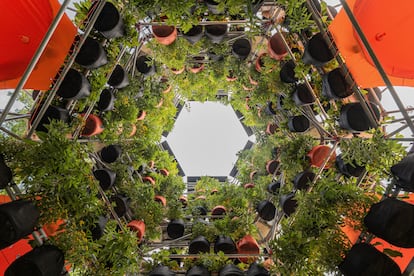

As summers become increasingly hot due to climate change, many cities are turning into uninhabitable ovens for months on end. Profound transformations are needed to help cities cope with rising temperatures, such as increasing green spaces and reducing asphalt coverage, but these changes can take decades. In the meantime, architects Belinda Tato and José Luis Vallejo have developed an innovative temporary solution at Harvard University to combat heat in areas lacking vegetation: a cost-effective climate shelter prototype made from simple materials, including scaffolding, solar panels, and flower pots. This shelter can be assembled quickly to provide cooling in various locations, from urban squares to unused parking lots.
Twenty-five years ago, Tato, 52, and Vallejo, 53, founded Ecosistema Urbano, a studio dedicated to innovating public spaces and enhancing the climatic comfort of cities. The studio’s notable projects include the Eco-boulevard in Vallecas, which transformed an area on the outskirts of Madrid into a climate-controlled public space in 2007. They have also undertaken projects across America, Africa, and Asia.
Currently, Tato is a professor of landscape architecture at Harvard University, while Vallejo teaches urban planning at Columbia University. Despite their academic commitments, they continue to actively manage their studio, which has offices in Madrid and Boston.
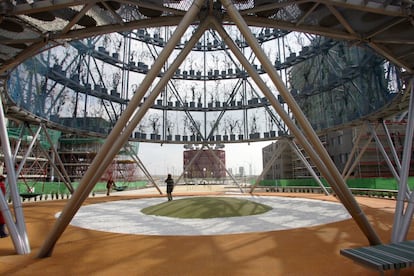
Their new prototype merges their two roles: research and planning. “This project aligns with the Eco-boulevard concept but addresses the need for an immediate, temporary solution when there is neither time nor money to build something permanent,” Tato explains during a video call from Cambridge, Massachusetts. “It can be assembled and dismantled without generating waste,” she continues. “This solution can be set up in just a few days and significantly improves climatic comfort in areas dominated by asphalt or concrete.”
The invention is called Polinature, and one of its main goals is to attract pollinators, which are increasingly threatened in urban environments. “Bees are disappearing from cities because of the heat island effect [where urban areas retain far more heat than surrounding regions], as well as the use of pesticides,” explains the expert. “But they are crucial to the food chain; without them, we would perish.”
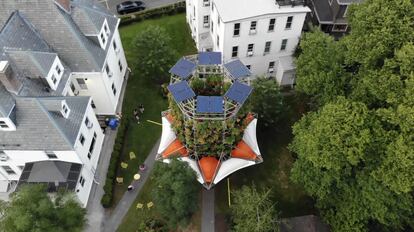
From the outside, the structure resembles a giant alien flower, while inside, everything is bathed in green. The temporary construction has a hexagonal shape, though it could easily take on other forms since it’s built with scaffolding. “All the components come from a standard construction catalog and are easy to get anywhere,” the designer explains. Standing at three and a half meters high, the structure features two types of inflatable canopies: white ones that provide shade, and orange ones that inflate to create airflow. Above this level are pots holding around 1,400 native Massachusetts plants, perfect for attracting insects.
Vallejo explains the rest of the operation. “The prototype is equipped with sensors distributed across the structure, measuring five key variables: temperature, humidity, solar radiation, wind speed, and air quality,” he says from Cambridge. “Then, an algorithm processes this data, and when certain thresholds are met, the fans activate and the orange canopies inflate, creating an air current that creates climatic comfort.”
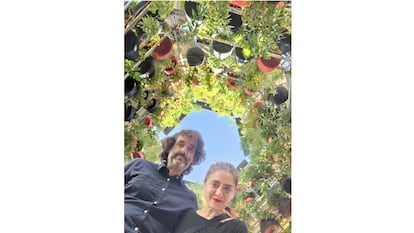
The structure is self-sufficient, as it has solar panels to power the sensors, bubbles and fans, as well as night lighting. Funding comes from Harvard University’s Salata Institute for Climate and Sustainability, and as planned, it will be dismantled in a few weeks. “We will now analyze the data and generate scientific knowledge to assess the viability of the prototype, learn from it and make future improvements,” Vallejo explains. Preliminary findings indicate that the temperature inside this climate shelter can be up to five degrees cooler, compared to the outdoor environment.
Create meeting points
“This can serve as a meeting point and help rehabilitate abandoned spaces, such as a parking lot looking to be reintegrated into the public space system, an unused lot, or a stark square,” Vallejo explains. Many Spanish cities feature such barren squares without vegetation or trees, like Madrid’s landmark Puerta del Sol square — where, just two years after its renovation, the city council is contemplating installing awnings.
Tato adds: “In Spain, there are numerous squares where trees were not planted due to the parking facilities beneath them. These areas can be unbearable during summer months when the heat intensifies. Our goal is to make these sun-scorched spaces more livable.”
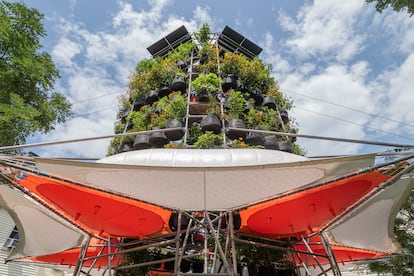
Meanwhile, in the United States, cities characterized by sprawl and heavy reliance on automobiles are often marked by expansive parking lots and neighborhoods devoid of greenery. Vallejo elaborates: “In the United States, the most disadvantaged neighborhoods are those with fewer trees, larger parking lots, and more asphalt and impermeable surfaces, making them significantly less livable during the summer months. These areas experience a pronounced heat island effect. Our solution could make a difference there.”
The creators say they are already in talks with several companies to find out how much it would cost to set up a similar structure in Spain. “The idea would be to make it as cheap as possible and offer it as an affordable product that can be set up and taken down in the summer in certain neighborhoods, or leave it semi-permanently, although it will depend on the companies that exist and the type of vegetation available,” says Tato. “Of course, cities have to become greener and more permeable, but these changes usually take years. We propose a prototype that can be installed in a few days in many spaces.”
Sign up for our weekly newsletter to get more English-language news coverage from EL PAÍS USA Edition
Tu suscripción se está usando en otro dispositivo
¿Quieres añadir otro usuario a tu suscripción?
Si continúas leyendo en este dispositivo, no se podrá leer en el otro.
FlechaTu suscripción se está usando en otro dispositivo y solo puedes acceder a EL PAÍS desde un dispositivo a la vez.
Si quieres compartir tu cuenta, cambia tu suscripción a la modalidad Premium, así podrás añadir otro usuario. Cada uno accederá con su propia cuenta de email, lo que os permitirá personalizar vuestra experiencia en EL PAÍS.
¿Tienes una suscripción de empresa? Accede aquí para contratar más cuentas.
En el caso de no saber quién está usando tu cuenta, te recomendamos cambiar tu contraseña aquí.
Si decides continuar compartiendo tu cuenta, este mensaje se mostrará en tu dispositivo y en el de la otra persona que está usando tu cuenta de forma indefinida, afectando a tu experiencia de lectura. Puedes consultar aquí los términos y condiciones de la suscripción digital.
More information
Archived In
Últimas noticias
The complicated life of Francesca Albanese: A rising figure in Italy but barred from every bank by Trump’s sanctions
Pinochet’s victims grapple with José Antonio Kast’s rise in Chile
Reinhard Genzel, Nobel laureate in physics: ‘One-minute videos will never give you the truth’
How Japan is trying to avert ‘digital defeat’
Most viewed
- Pablo Escobar’s hippos: A serious environmental problem, 40 years on
- Reinhard Genzel, Nobel laureate in physics: ‘One-minute videos will never give you the truth’
- Why we lost the habit of sleeping in two segments and how that changed our sense of time
- Charles Dubouloz, mountaineering star, retires at 36 with a farewell tour inspired by Walter Bonatti
- The Florida Keys tourist paradise is besieged by immigration agents: ‘We’ve never seen anything like this’










































